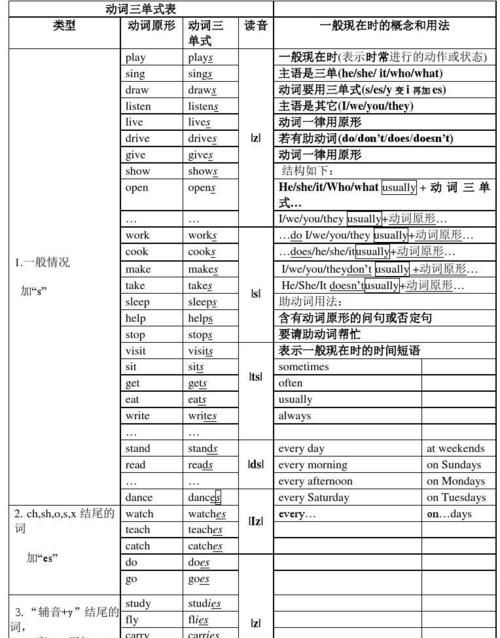本文目录
动词变为动名词的变化规律
6.1 动名词作主语、宾语和表语
1)作主语
Fighting broke out between the South and the North.
南方与北方开战了.
2)作宾语
a.动词后加动名词doing作宾语 V.+ doing sth
admit 承认
appreciate 感激,赞赏 avoid 避免
complete 完成 consider 认为
delay 耽误
deny 否认
detest 讨厌
endure 忍受
enjoy 喜欢
escape 逃脱
prevent阻止
fancy 想象
finish 完成
imagine 想象
mind 介意
miss 想念
postpone 推迟
practise 训练 recall 回忆
resent 讨厌
resist 抵抗
resume 继续
risk 冒险
suggest 建议 face 面对
include 包括
stand 忍受
understand 理解
forgive 宽恕
keep 继续
举例:
(1) Would you mind turning down your radio a little,please?
(2) The squirrel was lucky that it just missed being caught.
b.词组后接doing
admit to
prefer…to
be used to
lead to
devote oneself to object to
stick to
be busy
look forward to to为介词)
no good,no use,It's worth…,as well as,
can't help,It's no use /good be tired of
be fond of be capable of be afraid of
be proud of think of / about hold off
put off keep on insist on count on / upon
set about be successful in good at take up
give up burst out prevent … from…
3)作表语
Her job is washing,cleaning and taking care of the children.

英语动名词的用法总结
英语动名词用法介绍
动名词因同时拥有动词和名词两者的特点而拥有及其丰富的用法,熟练的掌握这些用法不仅可以使口语表达更地道生动,也能在写作中增分添彩。动名词主要有四种用法,做主语,作宾语,作表语,作定语,每种用法下又分小类别,是一个非常复杂庞大的系统,学习者们往往会理不清脉络,下面是我整理的相关内容,欢迎阅读参考!

一. 作主语
1. 直接位于句首
eg. Swimming is a good sport in summer.
2. 用 it 作形式主语,把动名词(真实主语)置于句尾作后置主语。
eg. It is no use telling him not to worry.
* important,essential,necessary 等形容词不能用于上述结构。
3. 用于“There be”结构中
eg. There is no saying when he'll come.
4. 动名词的复合结构作主语:当动名词有自己的逻辑主语时,常可以在前面加上一个名词或代词的所有格,构成动名词的复合结构, 动名词疑问句通常使用这种结构做主语
eg. Their coming to help was a great encouragement to us.
Does your saying that mean anything to him?
二. 作宾语
1. 作动词的.宾语
某些动词后出现非限定性动词时只能用动名词作宾语,不能用不定式。不定式通常指某种特定的动作,但动名词表示泛指,常见的此类动词有:
admit,appreciate,excuse,stand,advise,allow,permit,avoid,consider,enjoy,finish,give up,cannot help,imagine,include,keep,understand,keepon,mind,report,risk,miss,put off,delay,practise,resist,suggest,depend on,think about,set about,succeed in,worry about,burst out,insist on,feel like,be used to,get used to,devote…to…,look forward to,pay attention to,get down to,escape and so on.
eg. They went on walking and never stopped talking.他们继续走,说个不停。
2.作介词的宾语
动词+介词+动名词
eg.The rain prevented us from finishing the project.
形容词+介词+动名词
eg. I know who is responsible for breaking the window.
名词+介词+动名词
eg. We are thinking of making a new plan for the next term.
3.作形容词的宾语
eg. We are busy preparing for the coming test.
三. 作表语:
动名词作表语时句子主语常是无生命的事物的名词或what引导的名词性从句。表语动名词与主语通常是对等的关系,表示主语的内容,主语、表语可互换位置。如果句中的主语和表语同为动词时,要注意保持两个动词在形式上的一致。
eg. Your task is cleaning the windows.
四. 作定语: 动名词作定语往往表示被修饰词的某种用途。如:
eg. a reading room.(a room for reading)
;在英语中什么叫动名词短语
动名词:指的是动词ing形式的一种,兼有动词和名词特征的非限定动词。
动名词可以支配宾语,也能被副词修饰。动名词有时态和语态的变化。
英语中的动名词是由动词变化而来。一方面保留着动词的某些特征,具有动词的某些变化形式,用以表达名词所不能表达的较为复杂的意念,另一方面动名词在句子的用法及功能与名词类同:在句子中可以作主语、宾语、表语、定语。
动名词还可以被副词修饰或者用来支配宾语。但它没有时态变化而只有"式"的变化,分为一般式和完成式。

扩展资料:
动名词的作用:
1、作主语:动名词作主语,在动词的基础上加Ing,使该动词或动词短语,有名词的各种特征,可作名词灵活使用。
2、作表语:动名词作表语时句子主语常是表示无生命的事物的名词或what引导的名词性从句。表语动名词与主语通常是对等的关系,表示主语的内容,主语、表语可互换位置。
3、作宾语:用动名词作宾语表示一般的行为,或者是目前正在进行的行为。
4、作定语:动名词作定语往往表示被修饰词的某种用途。
参考资料来源:百度百科——动名词
英语的形容词有哪些单词
形容词修饰名词,动名词。副词修饰动词和形容词
动名词与名词可以做主语,与动词,形容词,副词联合成句
动名词是由动词转化过来的名词

以上就是关于动词动名词英语 ,动词变为动名词的变化规律的全部内容,以及动词动名词英语 的相关内容,希望能够帮到您。
